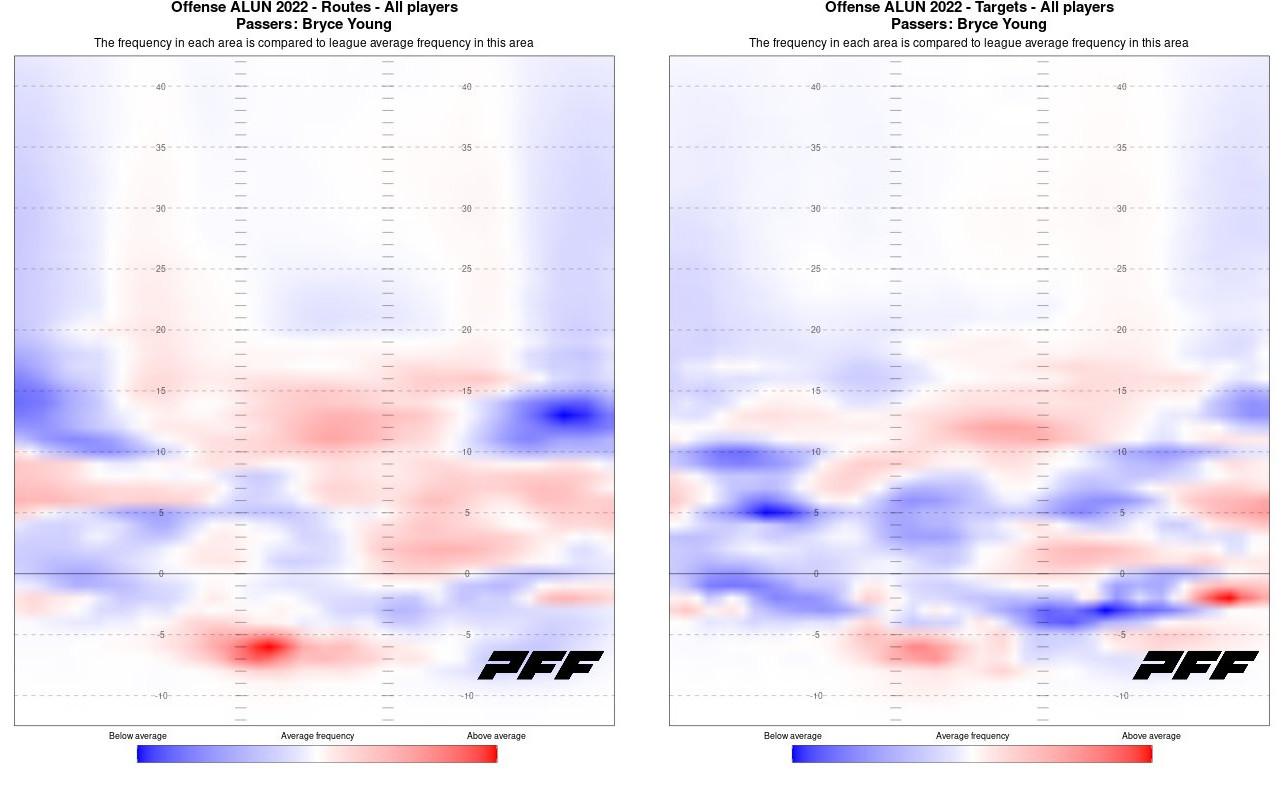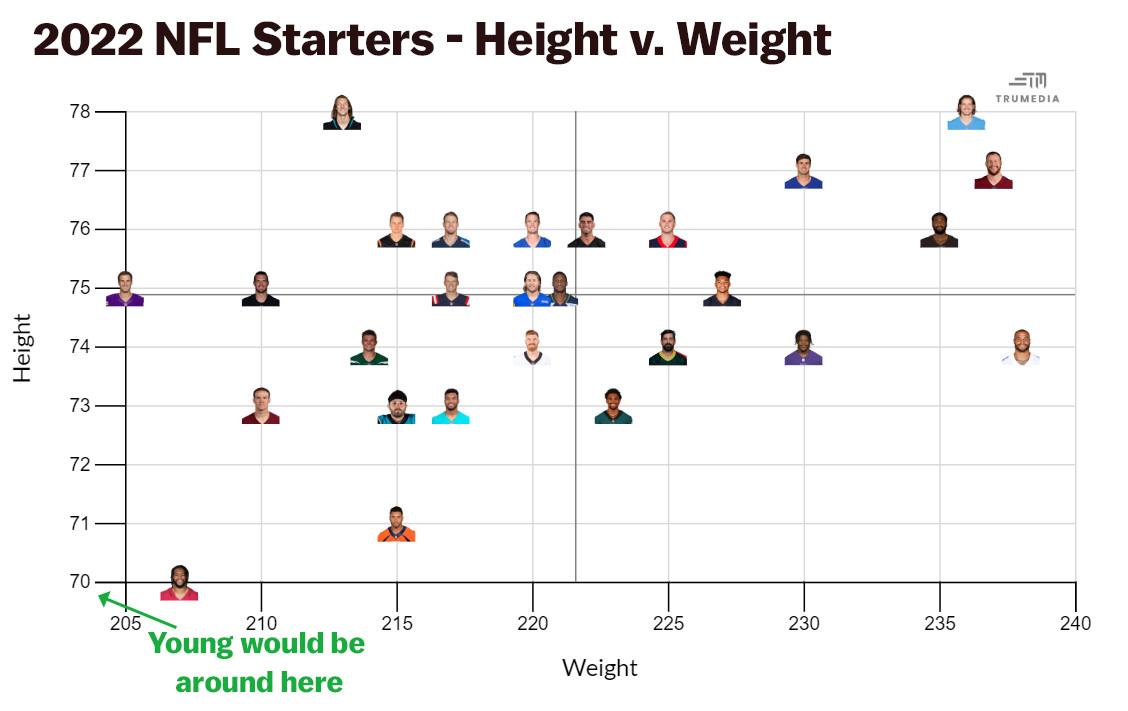
Two first-round picks, two second-round picks, and D.J. Moore. That’s the price the Carolina Panthers paid to draft Bryce Young first overall in the 2023 NFL draft on Thursday night, and it’s a sizable investment in a player who has a historically small frame. Carolina must have seen Young as the no-brainer pick for them to send that haul to the Bears in March. But any time you do a deal that big, it has to be viewed as a risk. Especially when no team in NFL history had traded up for the top pick to use it on a 5-foot-10 quarterback whose weight hovers around the Mendoza line. If this doesn’t work out, there will be a long line of people waiting to tell the Panthers: I told you so.
It’s not just that Carolina drafted an undersized prospect; it drafted him over one of the biggest, strongest, fastest prospects we’ve ever seen in Anthony Richardson, who also has the arm to match his impressive athleticism. The current prevailing opinion on the two players suggests that Carolina made the right move—Young passes the eye test on film, and he put up staggering numbers at Alabama. But if, years down the road, Richardson hits and Young fails in a predictable way, that won’t matter. The public doesn’t have to take accountability for its draft takes. The Panthers front office and coaching staff do. And they won’t just be getting retweeted by Freezing Cold Takes if things go south. They’ll be getting pink slips and declining ticket revenue.
There’s reason to suspect this experiment will work out for the rebuilding Panthers, though. Frank Reich, who was hired by the team in January, is a good head coach, and he’s brought in a dynamic staff that should get the most out of an improving roster. In Young, that staff has a promising quarterback it will try to shape into a star. No matter how things turn out in the future, today is undoubtedly a good day to be a Panthers fan.
Whether there are more of those days to come depends on how Young’s size translates to the NFL—because we already know the rest of his game will. Over his two full seasons as Alabama’s starter, Young amassed 8,200 passing yards, scored 79 touchdowns, and threw only 12 interceptions. He led the Tide to 23 wins in two years. If he were 6-foot-2 and played the exact same way, he’d be viewed as a generational, can’t-miss prospect like Trevor Lawrence or Joe Burrow. My comp for Young heading into the draft was a smaller Burrow: Both have a tremendous feel for the game, which allows them to remain calm in chaotic situations. Neither is particularly fast, and their arm strength is average, but they’ll still make ridiculous plays out of structure.
Like Burrow, Young is a keen observer before the snap. He uses that calm to survey the defense for tells, and he uses fake cadences to get defenders to tip their hands. The tireless pre-snap work Young does will undoubtedly help him at the next level. We’ve seen how crucial that can be for quarterbacks both in the past, like Peyton Manning and Tom Brady, and in today’s game, like Burrow and Dak Prescott. Young is in that mold.
But there is a clear difference between those guys and Young: the ease with which they can operate around the line of scrimmage. That has been an issue for the 21-year-old quarterback at times. Even if he’s able to see over his linemen to determine what the defense is doing, that doesn’t guarantee he’ll find the open man. At Alabama, Young did not throw many passes in the 5 yards beyond the line of scrimmage despite receivers running into that area a fair amount.

We can’t confidently pin that all on his height, but it is the most logical explanation. Even so, Young’s stature hasn’t stopped him from peppering the middle of the field, which is not something you typically see from sub-6-foot passers. NFL Network’s Cameron Wolfe says Young’s heat map, specifically that big splotch of red in the middle, is one of the reasons that Carolina doesn’t believe Young’s height will be an impediment throughout his career.
That logic is sound, but we also have to account for the different field dimensions at the college level. The hash marks are wider there, which spreads out the defense and opens up the middle of the field. You rarely see a throw like this on Sundays:
You’ll rarely see pockets like that either. Which brings up another question Young will have to answer in the NFL: How will he manage a tighter pocket? Young was kept well-protected on most plays behind the Tide’s line. But in games against stiffer competition, where throwing space was limited, he struggled in a collapsing pocket.
Pass protection matters for any young quarterback, but it will be paramount for Young. Fortunately for him, he’s going to a team with an ascending offensive line—one that could be a top-10 unit in 2023. He also has a coaching staff that knows how to protect its quarterback. Reich did wonders for Andrew Luck’s sack rate after the Colts quarterback spent the early part of his career taking hits at a ridiculous clip. Offensive coordinator Thomas Brown came over from the Rams, where Sean McVay successfully carved out space for an immobile Jared Goff using a high dosage of play-action.
Carolina could stand to bolster the interior of its line a bit more, not only to give Young some more room to breathe, but also to limit his trips outside of the pocket. The 2021 Heisman winner is pretty chill against edge pressure—he’ll just step up into the pocket—but when there’s pressure in his face, he almost always hits the eject button. Young is certainly capable of playing that backyard style of football, but it does invite more hits. And he won’t do the franchise any good being injured on the sideline. The Panthers will make an effort to keep him out of harm’s way, but Young will have to do his part too. He said in April that he’ll learn how to slide more often, but let’s check back in on that when he’s on the field trying to win games.
There isn’t a one-to-one correlation between size and injury avoidance, so maybe we shouldn’t be so concerned about Young staying healthy. Kirk Cousins is the lightest starting quarterback in the NFL and has never missed a start due to injury.

Of course, Cousins also rarely strays too far outside of the pocket unless it’s a designed part of the play, so maybe that’s not the most apt point of comparison. Russell Wilson and Jalen Hurts have also remained mostly healthy throughout their careers, but both are built like tanks. The most useful comp is Kyler Murray, who hasn’t finished a season without picking up some kind of knock. But judging Young on a sample size of one is also unfair.
Regardless, there’s a lot riding on Young’s ability to stay healthy. Panthers owner David Tepper needs a win to build up some goodwill with the fans. The coaching staff’s job security is now tied directly to Young’s development. And the fan base is desperate for a quarterback it can cheer for after spending the last few years in QB purgatory. All of this now rests in Young’s hands—which measured in the 61st percentile, in case you were wondering.

